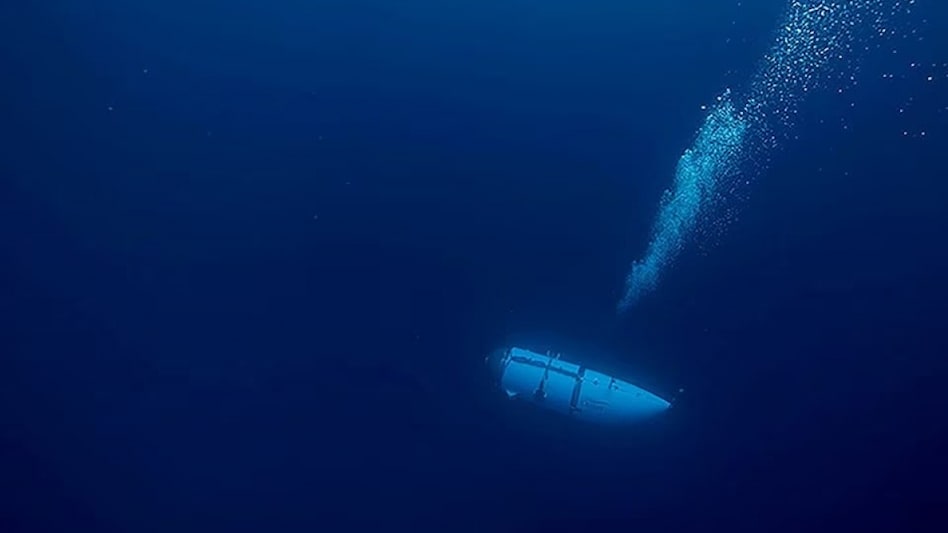 Titan, the submarine, went missing on Sunday, shortly after starting its descent to see the wreckage of the ill-fated Titanic.
Titan, the submarine, went missing on Sunday, shortly after starting its descent to see the wreckage of the ill-fated Titanic.  Titan, the submarine, went missing on Sunday, shortly after starting its descent to see the wreckage of the ill-fated Titanic.
Titan, the submarine, went missing on Sunday, shortly after starting its descent to see the wreckage of the ill-fated Titanic. The missing Titanic tourist submarine with five people onboard has limited oxygen which is expected to run out at any time now. Titan, the submarine, went missing on Sunday, shortly after starting its descent to see the wreckage of the ill-fated Titanic. The Titanic wreck lies at a depth of about 12,500 feet (3,810 metres).
Associated Press today reported that the submarine, operated by OceanGate, has 96 hours of oxygen and the search operation has neared that deadline. While rescuers continue to make all-out efforts to locate the missing submarine before it runs out of oxygen, an expert has said that this deadline is not necessarily rigid.
Depending on conditions, some of those aboard could survive longer than expected, Dr Ken LeDez, a hyperbaric medicine expert at Memorial University in St John's, Newfoundland, has told BBC News. "It depends on how cold they get and how effective they are at conserving oxygen," he said, adding that shivering will use up a lot of oxygen, while wrapping up in a huddle can help to conserve heat.
Dr LeDez said running out of oxygen is a gradual process. "It's not like switching off a light, it's like climbing a mountain - as the temperature gets colder and metabolism falls [it depends] how fast you ascend that mountain," he said. He admitted that he does not know the full situation inside the submersible but said conditions could be different from person-to-person, and that some could survive longer than others.
On Wednesday, Rear Admiral John Mauger from the US Coast Guard said there were a number of unknowns in the search and rescue mission. "We do not know the rate of consumption of oxygen per occupant on the sub," Rear Adm Mauger told the BBC.
Dr LeDez also said that running out of oxygen is not the only danger those on board face. The sub may have lost electrical power, which is likely to have a role in controlling the amount of oxygen and carbon dioxide inside the vessel. As the oxygen level drops, the proportion of carbon dioxide being breathed out by the crew will be rising, with potentially fatal consequences.
"As levels of carbon dioxide build-up, then it becomes sedative, it becomes like an anaesthetic gas, and you will go to sleep," the medicine expert said. Also, too much of the gas in a person's bloodstream, known as hypercapnia, can kill them if not treated.
Former Royal Navy submarine captain Ryan Ramsey said he looked at videos online of the inside of the submarine and could not see a carbon dioxide removal system, known as scrubbers. "That for me is the greatest problem of all of them," he said.
The crew are also at risk from hypothermia, where the body gets too cold. Capt Ramsey said that if the sub is on the seabed, the water temperature will be about 0C. If it has also lost electricity, it will not be generating any power and therefore cannot generate heat.
But hypothermia "could be their friend", Dr LeDez told BBC, adding that there is a possibility if they cool down enough and lose consciousness, they could live through it. The body will automatically try to adapt to survive, he said.
However, the lack of oxygen and the build-up of carbon dioxide within the sub may affect the crew's ability to make contact with the search and rescue mission, such as by banging on the hull at regular intervals to try and attract attention. "If they are unconscious, they're not going to be able to do much to help themselves," Dr LeDez said.
But despite these challenges, LeDez wants the search operation to continue as he believes that the travellers might be able to survive even when oxygen levels are very low.
The US Coast Guard on Wednesday that Canadian search planes had detected undersea noises. But the Coast Guard said remote-controlled underwater search vehicles directed to where the noises were detected had not yielded results. The officials said the sounds might not have originated from the missing submarine.
Meanwhile, a French ship carrying a deep-sea diving robot has neared the Titan search zone, Reuters reported on Thursday. Marine Traffic data showed the ship had slowed to a speed of 6 nautical knots and was located about 20 km to 30 km from the Polar Prince vessel which had carried the missing submarine to waters above the Titanic wreck.
Watch: Amul Girl creator Sylvester daCunha passes away, throwback to iconic Amul Ads